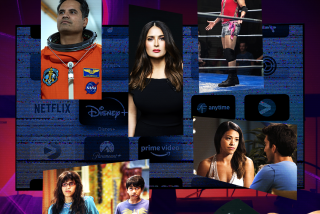The Bunny’s About to Make Big Hop Into Spanish-Language TV
- Share via
What sort of hombre watches Playboy? The publisher of the popular men’s magazine hopes he lives in a large city, is between 21 and 49--and speaks Spanish.
Chicago-based Playboy Enterprises announced this week Playboy TV en Espanol, a new 24-hour Spanish-language channel operated in conjunction with its overseas partner, the TV division of Cisneros Group, the privately held Venezuelan media giant.
The programming will consist of Playboy’s usual helpings of risque shows--in fact, Playboy has merely dubbed the English-language fare from its stateside cable operations and added sexy, Spanish-speaking “hostesses” between shows.
The companies hope the channel, which is borrowed from Playboy’s already existing satellite feed to Latin America and is expected to hit major cities, including Los Angeles, by August, will tap the increasingly important Latino market in the U.S., which has about 13.2 million adult Spanish speakers.
Latinos are “a very fast-growing and increasingly economically empowered segment of the audience,” says Anthony J. Lynn, president of Playboy Entertainment Group in Beverly Hills. “I think the potential is terrific for us.”
But the move may have as much to do with strategic positioning as ethnic marketing. As its flagship magazine continues to falter--ad pages at Playboy have dropped precipitously in recent years--Playboy is laying heavy bets that the entertainment unit under Lynn can profitably exploit the bunny brand. TV and video last year accounted for 29% of the company’s $318 million in total revenue--up from 21% of revenue just three years ago--and an important court victory involving its cable TV network has cleared the way for Playboy to press forward.
Indeed, Lynn says that the Spanish-language channel will help the company beat the rush of other broadcasters vying for channel space as digital television is expected to roll out in the coming months.
“We felt it was important to stake out our position in this marketplace sooner rather than later,” Lynn says.
It’s all part of an impressive turnaround at once-creaky Playboy, which has seen its stock price double in recent months after years of lolling around $14 a share. Playboy shares closed Tuesday up 13 cents to $27.81 on the New York Stock Exchange.
“Investors are beginning to realize that this isn’t your grandfather’s Playboy magazine,” says David S. Leibowitz, managing director of Burnham Securities in New York, who has tracked the company since it went public in 1971. Pointing to Playboy’s increasing stake in video, TV and Internet ventures, Leibowitz notes that “Playboy is in many ways a multimedia company . . . [with] very capable management.”
Playboy’s revival represents a combination of planning and some luck. The company suffered a heavy blow when a provision of the Telecommunications Act of 1996 prohibited cable operators from offering adult-oriented networks from 6 a.m. to 10 p.m. unless they installed special equipment to scramble the signal.
Playboy immediately sued over the law, which was designed to prevent soft-core fare from inadvertently “bleeding” into other cable channels. The provision would have crippled the company’s efforts to maintain a 24-hour subscription and pay-per-view service in the U.S., which in 1998 racked up $57 million in sales. Last December, a U.S. District Court panel declared the prohibition unconstitutional.
Meanwhile, Playboy bought Spice Entertainment, its largest competitor in adult-oriented TV, for $100 million in cash and stock. The deal, which Chief Executive Christie Hefner, the daughter of magazine founder Hugh Hefner, described in an interview as “a classic consolidation play,” has folded several networks into two Spice Channels, which offer more sexually explicit fare than is seen on Playboy’s subscription and pay-per-view service.
Yet perhaps the most important deal was with Cisneros, the $4-billion Caracas, Venezuela-based conglomerate that has a hand in everything from gold mining to the Spanish-language broadcaster Univision. The companies launched Playboy-branded networks in Latin America starting in 1996 and last year formed Playboy Television International, which will bring the formula to other territories, including those in Europe. As a result, Playboy is expected to get $100 million in licensing fees and royalty payments over the next five years.
Playboy TV en Espanol is the latest fruit from the Cisneros relationship. Lynn admits that it might be tough to find carriage on many cable outlets at first.
“We’ve had very good response from a number of systems in Southern California, Texas and Florida, and we expect to be carried in some of those cities very quickly,” he says. Elsewhere, the company will probably have to wait until digital TV opens up more channel positions in coming months. Lynn stresses that the company’s investment in the new network is minimal, since it already owns the programming and the satellite feed already exists.
The entertainment division is trading exclusively on the powerful brand name and image developed by the magazine, which has been limping along for years. Ad pages in 1997 sank to 558, down 15% from 1993, and the magazine has reported recent declines in subscription revenue.
“It’s not that Playboy is suffering at the hands of competing magazines,” Leibowitz says. “The magazine is competing with other media --the VCR is the main one.”
But Christie Hefner suggests that a push toward celebrity coverage--and “un-coverage,” as demonstrated by recent nude pictorials of Katarina Witt and Cindy Crawford--will reverse the magazine’s fading fortunes. What’s more, her newly single, 73-year-old father has revived the freewheeling party ambience at the Playboy Mansion in Holmby Hills, generating a fresh splash of publicity aimed at the “Swingers” generation.
“Sometimes the brand name is a mixed blessing,” Lynn concedes, but “it carries its weight.”
More to Read
The biggest entertainment stories
Get our big stories about Hollywood, film, television, music, arts, culture and more right in your inbox as soon as they publish.
You may occasionally receive promotional content from the Los Angeles Times.











